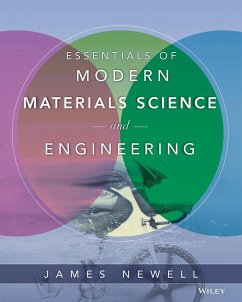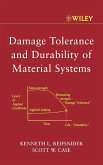James A. Newell
Essentials of Modern Materials Science and Engineering
James A. Newell
Essentials of Modern Materials Science and Engineering
- Gebundenes Buch
- Merkliste
- Auf die Merkliste
- Bewerten Bewerten
- Teilen
- Produkt teilen
- Produkterinnerung
- Produkterinnerung
While other materials science books focus heavily on metals, Newell s Material Science and Engineering offers a unique approach that emphasizes modern materials such as polymers, ceramics, and composites. The book explores the key concepts and fundamentals that are needed to make informed decisions in the field. The importance of economics in decision-making and consideration of the entire life cycle of products are themes that are also integrated throughout the chapters. Engineers will be able to use this as a reference for the materials selection issues that they ll deal with throughout their careers.…mehr
Andere Kunden interessierten sich auch für
![Essentials of Materials Science and Technology Essentials of Materials Science and Technology]() Essentials of Materials Science and Technology134,99 €
Essentials of Materials Science and Technology134,99 €![The Advanced Materials Revolution The Advanced Materials Revolution]() Sanford L. MoskowitzThe Advanced Materials Revolution118,99 €
Sanford L. MoskowitzThe Advanced Materials Revolution118,99 €![Kinetics of Materials Kinetics of Materials]() Robert W. BalluffiKinetics of Materials148,99 €
Robert W. BalluffiKinetics of Materials148,99 €![Damage Tolerance and Durability of Material Systems Damage Tolerance and Durability of Material Systems]() Kenneth L. ReifsniderDamage Tolerance and Durability of Material Systems223,99 €
Kenneth L. ReifsniderDamage Tolerance and Durability of Material Systems223,99 €![Introduction to Tribology Introduction to Tribology]() Bharat BhushanIntroduction to Tribology201,99 €
Bharat BhushanIntroduction to Tribology201,99 €![The Handbook of Advanced Materials The Handbook of Advanced Materials]() The Handbook of Advanced Materials263,99 €
The Handbook of Advanced Materials263,99 €![Frp Frp]() J G TengFrp190,99 €
J G TengFrp190,99 €-
-
-
While other materials science books focus heavily on metals, Newell s Material Science and Engineering offers a unique approach that emphasizes modern materials such as polymers, ceramics, and composites. The book explores the key concepts and fundamentals that are needed to make informed decisions in the field. The importance of economics in decision-making and consideration of the entire life cycle of products are themes that are also integrated throughout the chapters. Engineers will be able to use this as a reference for the materials selection issues that they ll deal with throughout their careers.
Hinweis: Dieser Artikel kann nur an eine deutsche Lieferadresse ausgeliefert werden.
Hinweis: Dieser Artikel kann nur an eine deutsche Lieferadresse ausgeliefert werden.
Produktdetails
- Produktdetails
- Verlag: Wiley & Sons
- 1. Auflage
- Seitenzahl: 368
- Erscheinungstermin: 1. Dezember 2008
- Englisch
- Abmessung: 251mm x 201mm x 15mm
- Gewicht: 597g
- ISBN-13: 9780471753650
- ISBN-10: 0471753653
- Artikelnr.: 25065589
- Herstellerkennzeichnung
- Libri GmbH
- Europaallee 1
- 36244 Bad Hersfeld
- gpsr@libri.de
- Verlag: Wiley & Sons
- 1. Auflage
- Seitenzahl: 368
- Erscheinungstermin: 1. Dezember 2008
- Englisch
- Abmessung: 251mm x 201mm x 15mm
- Gewicht: 597g
- ISBN-13: 9780471753650
- ISBN-10: 0471753653
- Artikelnr.: 25065589
- Herstellerkennzeichnung
- Libri GmbH
- Europaallee 1
- 36244 Bad Hersfeld
- gpsr@libri.de
Dr. James A. Newell is a professor of engineering at Rowan University. He received his PhD in engineering concentrating in polymers from Clemson in 1994. In 1997, he was named as the Dow Outstanding New Faculty Member by the North Midwest section of the American Society for Engineering Education (ASEE). In 2001, he received the Ray Fahien Award from ASEE for contributions to Chemical Engineering education. Along with Kevin Dahm, he also received the 2001 Professional Interest Council Group III (PIC-III) Best Paper Award at the 2001 ASEE conference in Albuquerque.
Chapter 1 Introduction 2
WHY STUDY MATERIALS SCIENCE? 4
1.1 Overview of Materials Science 4
WHAT ISSUES IMPACT MATERIALS SELECTION AND DESIGN? 4
1.2 Property Considerations for Specifi c Applications 5
1.3 Impact of Bonding of Material Properties 10
1.4 Changes of Properties over Time 17
1.5 Impact of Economics on Decision Making 18
1.6 Sustainability and Green Engineering 18
WHAT CHOICES ARE AVAILABLE? 21
1.7 Classes of Materials 21
Chapter 2 Structure in Materials 30
HOW ARE ATOMS ARRANGED IN MATERIALS? 32
2.1 Introduction 32
2.2 Levels of Order 33
2.3 Lattice Parameters and Atomic Packing Factors 36
2.4 Density Estimations 40
2.5 Crystallographic Planes 41
2.6 Miller Indices 43
HOW ARE CRYSTALS MEASURED? 45
2.7 X-Ray Diffraction 45
2.8 Microscopy 52
HOW DO CRYSTALS FORM AND GROW? 53
2.9 Nucleation and Grain Growth 53
WHAT KINDS OF FLAWS ARE PRESENT IN CRYSTALS AND WHAT DO THEY AFFECT? 54
2.10 Point Defects 54
2.11 Dislocations 55
2.12 Slip 56
2.13 Dislocation Climb 59
WHAT NEW DEVELOPMENTS ARE HAPPENING WITH CRYSTALS AND CRYSTAL STRUCTURES?
60
2.14 Monocrystals and Nanocrystals 60
Chapter 3 Measurement of Mechanical Properties 66
HOW DO I KNOW HOW TO MEASURE PROPERTIES? 68
3.1 ASTM Standards 68
WHAT PROPERTIES CAN BE MEASURED AND WHAT DO THEY TELL ME? 69
3.2 Tensile Testing 69
3.3 Compressive Testing 79
3.4 Bend Testing 80
3.5 Hardness Testing 80
3.6 Creep Testing 83
3.7 Impact Testing 84
WILL I GET THE SAME RESULT EVERY TIME I RUN A SPECIFIC TEST? 86
3.8 Error and Reproducibility in Measurement 86
WHY DO MATERIALS FAIL UNDER STRESS? 91
3.9 Fracture Mechanics 91
HOW DO MECHANICAL PROPERTIES CHANGE OVER TIME? 94
3.10 Fatigue Testing 95
3.11 Accelerated Aging Studies 96
Chapter 4 Metals 104
HOW DO YOU WORK WITH METALS? 106
4.1 Forming Operations 106
WHAT ADVANTAGES DO ALLOYS OFFER? 110
4.2 Alloys and Phase Diagrams 110
4.3 Carbon Steel 118
4.4 Phase Transitions 127
4.5 Age Hardening (Precipitation Hardening) 131
4.6 Copper and Its Alloys 132
4.7 Aluminum and Its Alloys 135
WHAT LIMITATIONS DO METALS HAVE? 137
4.8 Corrosion 137
WHAT HAPPENS TO METALS AFTER THEIR COMMERCIAL LIFE? 141
4.9 Recycling of Metals 141
Chapter 5 Polymers 148
WHAT ARE POLYMERS? 150
5.1 Polymer Terminology 150
5.2 Types of Polymers 153
HOW ARE POLYMER CHAINS FORMED? 161
5.3 Addition Polymerization 162
5.4 Condensation Polymerization 163
5.5 Importance of Molecular Weight Distributions 165
WHAT INFLUENCES THE PROPERTIES OF POLYMERS? 167
5.6 Constitution 167
5.7 Configuration 169
5.8 Conformation 173
5.9 Additives 176
HOW ARE POLYMERS PROCESSED INTO COMMERCIAL PRODUCTS? 177
5.10 Polymer Processing 177
WHAT HAPPENS TO POLYMERS WHEN THEY ARE DISCARDED? 181
5.11 Recycling of Polymers 181
Chapter 6 Ceramics and Carbon Materials 188
WHAT ARE CERAMIC MATERIALS? 190
6.1 Crystal Structures in Ceramics 190
WHAT ARE THE INDUSTRIAL USES OF CERAMICS? 198
6.2 Abrasives 198
6.3 Glasses 201
6.4 Cements 204
6.5 Refractories 209
6.6 Structural Clay Products 210
6.7 Whitewares 210
6.8 Advanced Ceramics 212
WHAT HAPPENS TO CERAMIC MATERIALS AT THE END OF THEIR USEFUL LIVES? 213
6.9 Recycling of Ceramic Materials 213
IS GRAPHITE A POLYMER OR A CERAMIC? 214
6.10 Graphite 214
DO OTHER CARBON MATERIALS OFFER UNUSUAL PROPERTIES? 215
6.11 Diamond 215
6.12 Carbon Fibers 216
6.13 Fullerenes (Buckyballs) and Carbon Nanotubes 219
Chapter 7 Composites 224
WHAT ARE COMPOSITE MATERIALS AND HOW ARE THEY MADE? 226
7.1 Classes of Composites 226
7.2 Fiber-Reinforced Composites 227
7.3 Particulate Composites 237
7.4 Laminar Composites 242
WHAT HAPPENS TO OBSOLETE COMPOSITES? 243
7.5 Recycling of Composite Materials 243
Chapter 8 Electronic and Optical Materials 246
HOW DO ELECTRONS FLOW THROUGH METALS? 248
8.1 Conductivity in Metals 248
8.2 Electrical Resistivity 253
WHAT HAPPENS WHEN THERE ARE NO FREE ELECTRONS? 254
8.3 Insulators 254
8.4 Intrinsic Semiconduction 254
8.5 Extrinsic Semiconduction 256
HOW DO ELECTRONIC DEVICES OPERATE? 258
8.6 Diodes 258
8.7 Transistors 259
8.8 Integrated Circuits 260
8.9 Dielectric Behavior and Capacitors 261
WHAT OTHER ELECTRICAL BEHAVIORS DO SOME MATERIALS DISPLAY? 262
8.10 Ferroelectric and Piezoelectric Materials 262
WHAT ARE OPTICAL PROPERTIES AND WHY DO THEY MATTER? 263
8.11 Optical Properties 263
8.12 Applications of Optical Materials 267
Chapter 9 Biomaterials and Biological Materials 272
WHAT TYPES OF MATERIALS INTERACT WITH BIOLOGICAL SYSTEMS? 274
9.1 Biomaterials, Biological Materials, and Biocompatibility 274
WHAT BIOLOGICAL MATERIALS PROVIDE STRUCTURAL SUPPORT AND WHAT BIOMATERIALS
INTERACT WITH OR REPLACE THEM? 275
9.2 Structural Biological Materials and Biomaterials 275
WHAT BIOMATERIALS SERVE A NONSTRUCTURAL FUNCTION IN THE BODY? 285
9.3 Functional Biomaterials 285
WHAT ETHICAL ISSUES ARE UNIQUE TO BIOMATERIALS? 294
9.4 Ethics and Biomaterials 294
APPENDIX A: MAJOR PRODUCERS OF METALS AND POLYMERS 299
APPENDIX B: PROPERTIES OF MAJOR METALS AND ALLOYS 303
Glossary 309
Index 327
WHY STUDY MATERIALS SCIENCE? 4
1.1 Overview of Materials Science 4
WHAT ISSUES IMPACT MATERIALS SELECTION AND DESIGN? 4
1.2 Property Considerations for Specifi c Applications 5
1.3 Impact of Bonding of Material Properties 10
1.4 Changes of Properties over Time 17
1.5 Impact of Economics on Decision Making 18
1.6 Sustainability and Green Engineering 18
WHAT CHOICES ARE AVAILABLE? 21
1.7 Classes of Materials 21
Chapter 2 Structure in Materials 30
HOW ARE ATOMS ARRANGED IN MATERIALS? 32
2.1 Introduction 32
2.2 Levels of Order 33
2.3 Lattice Parameters and Atomic Packing Factors 36
2.4 Density Estimations 40
2.5 Crystallographic Planes 41
2.6 Miller Indices 43
HOW ARE CRYSTALS MEASURED? 45
2.7 X-Ray Diffraction 45
2.8 Microscopy 52
HOW DO CRYSTALS FORM AND GROW? 53
2.9 Nucleation and Grain Growth 53
WHAT KINDS OF FLAWS ARE PRESENT IN CRYSTALS AND WHAT DO THEY AFFECT? 54
2.10 Point Defects 54
2.11 Dislocations 55
2.12 Slip 56
2.13 Dislocation Climb 59
WHAT NEW DEVELOPMENTS ARE HAPPENING WITH CRYSTALS AND CRYSTAL STRUCTURES?
60
2.14 Monocrystals and Nanocrystals 60
Chapter 3 Measurement of Mechanical Properties 66
HOW DO I KNOW HOW TO MEASURE PROPERTIES? 68
3.1 ASTM Standards 68
WHAT PROPERTIES CAN BE MEASURED AND WHAT DO THEY TELL ME? 69
3.2 Tensile Testing 69
3.3 Compressive Testing 79
3.4 Bend Testing 80
3.5 Hardness Testing 80
3.6 Creep Testing 83
3.7 Impact Testing 84
WILL I GET THE SAME RESULT EVERY TIME I RUN A SPECIFIC TEST? 86
3.8 Error and Reproducibility in Measurement 86
WHY DO MATERIALS FAIL UNDER STRESS? 91
3.9 Fracture Mechanics 91
HOW DO MECHANICAL PROPERTIES CHANGE OVER TIME? 94
3.10 Fatigue Testing 95
3.11 Accelerated Aging Studies 96
Chapter 4 Metals 104
HOW DO YOU WORK WITH METALS? 106
4.1 Forming Operations 106
WHAT ADVANTAGES DO ALLOYS OFFER? 110
4.2 Alloys and Phase Diagrams 110
4.3 Carbon Steel 118
4.4 Phase Transitions 127
4.5 Age Hardening (Precipitation Hardening) 131
4.6 Copper and Its Alloys 132
4.7 Aluminum and Its Alloys 135
WHAT LIMITATIONS DO METALS HAVE? 137
4.8 Corrosion 137
WHAT HAPPENS TO METALS AFTER THEIR COMMERCIAL LIFE? 141
4.9 Recycling of Metals 141
Chapter 5 Polymers 148
WHAT ARE POLYMERS? 150
5.1 Polymer Terminology 150
5.2 Types of Polymers 153
HOW ARE POLYMER CHAINS FORMED? 161
5.3 Addition Polymerization 162
5.4 Condensation Polymerization 163
5.5 Importance of Molecular Weight Distributions 165
WHAT INFLUENCES THE PROPERTIES OF POLYMERS? 167
5.6 Constitution 167
5.7 Configuration 169
5.8 Conformation 173
5.9 Additives 176
HOW ARE POLYMERS PROCESSED INTO COMMERCIAL PRODUCTS? 177
5.10 Polymer Processing 177
WHAT HAPPENS TO POLYMERS WHEN THEY ARE DISCARDED? 181
5.11 Recycling of Polymers 181
Chapter 6 Ceramics and Carbon Materials 188
WHAT ARE CERAMIC MATERIALS? 190
6.1 Crystal Structures in Ceramics 190
WHAT ARE THE INDUSTRIAL USES OF CERAMICS? 198
6.2 Abrasives 198
6.3 Glasses 201
6.4 Cements 204
6.5 Refractories 209
6.6 Structural Clay Products 210
6.7 Whitewares 210
6.8 Advanced Ceramics 212
WHAT HAPPENS TO CERAMIC MATERIALS AT THE END OF THEIR USEFUL LIVES? 213
6.9 Recycling of Ceramic Materials 213
IS GRAPHITE A POLYMER OR A CERAMIC? 214
6.10 Graphite 214
DO OTHER CARBON MATERIALS OFFER UNUSUAL PROPERTIES? 215
6.11 Diamond 215
6.12 Carbon Fibers 216
6.13 Fullerenes (Buckyballs) and Carbon Nanotubes 219
Chapter 7 Composites 224
WHAT ARE COMPOSITE MATERIALS AND HOW ARE THEY MADE? 226
7.1 Classes of Composites 226
7.2 Fiber-Reinforced Composites 227
7.3 Particulate Composites 237
7.4 Laminar Composites 242
WHAT HAPPENS TO OBSOLETE COMPOSITES? 243
7.5 Recycling of Composite Materials 243
Chapter 8 Electronic and Optical Materials 246
HOW DO ELECTRONS FLOW THROUGH METALS? 248
8.1 Conductivity in Metals 248
8.2 Electrical Resistivity 253
WHAT HAPPENS WHEN THERE ARE NO FREE ELECTRONS? 254
8.3 Insulators 254
8.4 Intrinsic Semiconduction 254
8.5 Extrinsic Semiconduction 256
HOW DO ELECTRONIC DEVICES OPERATE? 258
8.6 Diodes 258
8.7 Transistors 259
8.8 Integrated Circuits 260
8.9 Dielectric Behavior and Capacitors 261
WHAT OTHER ELECTRICAL BEHAVIORS DO SOME MATERIALS DISPLAY? 262
8.10 Ferroelectric and Piezoelectric Materials 262
WHAT ARE OPTICAL PROPERTIES AND WHY DO THEY MATTER? 263
8.11 Optical Properties 263
8.12 Applications of Optical Materials 267
Chapter 9 Biomaterials and Biological Materials 272
WHAT TYPES OF MATERIALS INTERACT WITH BIOLOGICAL SYSTEMS? 274
9.1 Biomaterials, Biological Materials, and Biocompatibility 274
WHAT BIOLOGICAL MATERIALS PROVIDE STRUCTURAL SUPPORT AND WHAT BIOMATERIALS
INTERACT WITH OR REPLACE THEM? 275
9.2 Structural Biological Materials and Biomaterials 275
WHAT BIOMATERIALS SERVE A NONSTRUCTURAL FUNCTION IN THE BODY? 285
9.3 Functional Biomaterials 285
WHAT ETHICAL ISSUES ARE UNIQUE TO BIOMATERIALS? 294
9.4 Ethics and Biomaterials 294
APPENDIX A: MAJOR PRODUCERS OF METALS AND POLYMERS 299
APPENDIX B: PROPERTIES OF MAJOR METALS AND ALLOYS 303
Glossary 309
Index 327
Chapter 1 Introduction 2
WHY STUDY MATERIALS SCIENCE? 4
1.1 Overview of Materials Science 4
WHAT ISSUES IMPACT MATERIALS SELECTION AND DESIGN? 4
1.2 Property Considerations for Specifi c Applications 5
1.3 Impact of Bonding of Material Properties 10
1.4 Changes of Properties over Time 17
1.5 Impact of Economics on Decision Making 18
1.6 Sustainability and Green Engineering 18
WHAT CHOICES ARE AVAILABLE? 21
1.7 Classes of Materials 21
Chapter 2 Structure in Materials 30
HOW ARE ATOMS ARRANGED IN MATERIALS? 32
2.1 Introduction 32
2.2 Levels of Order 33
2.3 Lattice Parameters and Atomic Packing Factors 36
2.4 Density Estimations 40
2.5 Crystallographic Planes 41
2.6 Miller Indices 43
HOW ARE CRYSTALS MEASURED? 45
2.7 X-Ray Diffraction 45
2.8 Microscopy 52
HOW DO CRYSTALS FORM AND GROW? 53
2.9 Nucleation and Grain Growth 53
WHAT KINDS OF FLAWS ARE PRESENT IN CRYSTALS AND WHAT DO THEY AFFECT? 54
2.10 Point Defects 54
2.11 Dislocations 55
2.12 Slip 56
2.13 Dislocation Climb 59
WHAT NEW DEVELOPMENTS ARE HAPPENING WITH CRYSTALS AND CRYSTAL STRUCTURES?
60
2.14 Monocrystals and Nanocrystals 60
Chapter 3 Measurement of Mechanical Properties 66
HOW DO I KNOW HOW TO MEASURE PROPERTIES? 68
3.1 ASTM Standards 68
WHAT PROPERTIES CAN BE MEASURED AND WHAT DO THEY TELL ME? 69
3.2 Tensile Testing 69
3.3 Compressive Testing 79
3.4 Bend Testing 80
3.5 Hardness Testing 80
3.6 Creep Testing 83
3.7 Impact Testing 84
WILL I GET THE SAME RESULT EVERY TIME I RUN A SPECIFIC TEST? 86
3.8 Error and Reproducibility in Measurement 86
WHY DO MATERIALS FAIL UNDER STRESS? 91
3.9 Fracture Mechanics 91
HOW DO MECHANICAL PROPERTIES CHANGE OVER TIME? 94
3.10 Fatigue Testing 95
3.11 Accelerated Aging Studies 96
Chapter 4 Metals 104
HOW DO YOU WORK WITH METALS? 106
4.1 Forming Operations 106
WHAT ADVANTAGES DO ALLOYS OFFER? 110
4.2 Alloys and Phase Diagrams 110
4.3 Carbon Steel 118
4.4 Phase Transitions 127
4.5 Age Hardening (Precipitation Hardening) 131
4.6 Copper and Its Alloys 132
4.7 Aluminum and Its Alloys 135
WHAT LIMITATIONS DO METALS HAVE? 137
4.8 Corrosion 137
WHAT HAPPENS TO METALS AFTER THEIR COMMERCIAL LIFE? 141
4.9 Recycling of Metals 141
Chapter 5 Polymers 148
WHAT ARE POLYMERS? 150
5.1 Polymer Terminology 150
5.2 Types of Polymers 153
HOW ARE POLYMER CHAINS FORMED? 161
5.3 Addition Polymerization 162
5.4 Condensation Polymerization 163
5.5 Importance of Molecular Weight Distributions 165
WHAT INFLUENCES THE PROPERTIES OF POLYMERS? 167
5.6 Constitution 167
5.7 Configuration 169
5.8 Conformation 173
5.9 Additives 176
HOW ARE POLYMERS PROCESSED INTO COMMERCIAL PRODUCTS? 177
5.10 Polymer Processing 177
WHAT HAPPENS TO POLYMERS WHEN THEY ARE DISCARDED? 181
5.11 Recycling of Polymers 181
Chapter 6 Ceramics and Carbon Materials 188
WHAT ARE CERAMIC MATERIALS? 190
6.1 Crystal Structures in Ceramics 190
WHAT ARE THE INDUSTRIAL USES OF CERAMICS? 198
6.2 Abrasives 198
6.3 Glasses 201
6.4 Cements 204
6.5 Refractories 209
6.6 Structural Clay Products 210
6.7 Whitewares 210
6.8 Advanced Ceramics 212
WHAT HAPPENS TO CERAMIC MATERIALS AT THE END OF THEIR USEFUL LIVES? 213
6.9 Recycling of Ceramic Materials 213
IS GRAPHITE A POLYMER OR A CERAMIC? 214
6.10 Graphite 214
DO OTHER CARBON MATERIALS OFFER UNUSUAL PROPERTIES? 215
6.11 Diamond 215
6.12 Carbon Fibers 216
6.13 Fullerenes (Buckyballs) and Carbon Nanotubes 219
Chapter 7 Composites 224
WHAT ARE COMPOSITE MATERIALS AND HOW ARE THEY MADE? 226
7.1 Classes of Composites 226
7.2 Fiber-Reinforced Composites 227
7.3 Particulate Composites 237
7.4 Laminar Composites 242
WHAT HAPPENS TO OBSOLETE COMPOSITES? 243
7.5 Recycling of Composite Materials 243
Chapter 8 Electronic and Optical Materials 246
HOW DO ELECTRONS FLOW THROUGH METALS? 248
8.1 Conductivity in Metals 248
8.2 Electrical Resistivity 253
WHAT HAPPENS WHEN THERE ARE NO FREE ELECTRONS? 254
8.3 Insulators 254
8.4 Intrinsic Semiconduction 254
8.5 Extrinsic Semiconduction 256
HOW DO ELECTRONIC DEVICES OPERATE? 258
8.6 Diodes 258
8.7 Transistors 259
8.8 Integrated Circuits 260
8.9 Dielectric Behavior and Capacitors 261
WHAT OTHER ELECTRICAL BEHAVIORS DO SOME MATERIALS DISPLAY? 262
8.10 Ferroelectric and Piezoelectric Materials 262
WHAT ARE OPTICAL PROPERTIES AND WHY DO THEY MATTER? 263
8.11 Optical Properties 263
8.12 Applications of Optical Materials 267
Chapter 9 Biomaterials and Biological Materials 272
WHAT TYPES OF MATERIALS INTERACT WITH BIOLOGICAL SYSTEMS? 274
9.1 Biomaterials, Biological Materials, and Biocompatibility 274
WHAT BIOLOGICAL MATERIALS PROVIDE STRUCTURAL SUPPORT AND WHAT BIOMATERIALS
INTERACT WITH OR REPLACE THEM? 275
9.2 Structural Biological Materials and Biomaterials 275
WHAT BIOMATERIALS SERVE A NONSTRUCTURAL FUNCTION IN THE BODY? 285
9.3 Functional Biomaterials 285
WHAT ETHICAL ISSUES ARE UNIQUE TO BIOMATERIALS? 294
9.4 Ethics and Biomaterials 294
APPENDIX A: MAJOR PRODUCERS OF METALS AND POLYMERS 299
APPENDIX B: PROPERTIES OF MAJOR METALS AND ALLOYS 303
Glossary 309
Index 327
WHY STUDY MATERIALS SCIENCE? 4
1.1 Overview of Materials Science 4
WHAT ISSUES IMPACT MATERIALS SELECTION AND DESIGN? 4
1.2 Property Considerations for Specifi c Applications 5
1.3 Impact of Bonding of Material Properties 10
1.4 Changes of Properties over Time 17
1.5 Impact of Economics on Decision Making 18
1.6 Sustainability and Green Engineering 18
WHAT CHOICES ARE AVAILABLE? 21
1.7 Classes of Materials 21
Chapter 2 Structure in Materials 30
HOW ARE ATOMS ARRANGED IN MATERIALS? 32
2.1 Introduction 32
2.2 Levels of Order 33
2.3 Lattice Parameters and Atomic Packing Factors 36
2.4 Density Estimations 40
2.5 Crystallographic Planes 41
2.6 Miller Indices 43
HOW ARE CRYSTALS MEASURED? 45
2.7 X-Ray Diffraction 45
2.8 Microscopy 52
HOW DO CRYSTALS FORM AND GROW? 53
2.9 Nucleation and Grain Growth 53
WHAT KINDS OF FLAWS ARE PRESENT IN CRYSTALS AND WHAT DO THEY AFFECT? 54
2.10 Point Defects 54
2.11 Dislocations 55
2.12 Slip 56
2.13 Dislocation Climb 59
WHAT NEW DEVELOPMENTS ARE HAPPENING WITH CRYSTALS AND CRYSTAL STRUCTURES?
60
2.14 Monocrystals and Nanocrystals 60
Chapter 3 Measurement of Mechanical Properties 66
HOW DO I KNOW HOW TO MEASURE PROPERTIES? 68
3.1 ASTM Standards 68
WHAT PROPERTIES CAN BE MEASURED AND WHAT DO THEY TELL ME? 69
3.2 Tensile Testing 69
3.3 Compressive Testing 79
3.4 Bend Testing 80
3.5 Hardness Testing 80
3.6 Creep Testing 83
3.7 Impact Testing 84
WILL I GET THE SAME RESULT EVERY TIME I RUN A SPECIFIC TEST? 86
3.8 Error and Reproducibility in Measurement 86
WHY DO MATERIALS FAIL UNDER STRESS? 91
3.9 Fracture Mechanics 91
HOW DO MECHANICAL PROPERTIES CHANGE OVER TIME? 94
3.10 Fatigue Testing 95
3.11 Accelerated Aging Studies 96
Chapter 4 Metals 104
HOW DO YOU WORK WITH METALS? 106
4.1 Forming Operations 106
WHAT ADVANTAGES DO ALLOYS OFFER? 110
4.2 Alloys and Phase Diagrams 110
4.3 Carbon Steel 118
4.4 Phase Transitions 127
4.5 Age Hardening (Precipitation Hardening) 131
4.6 Copper and Its Alloys 132
4.7 Aluminum and Its Alloys 135
WHAT LIMITATIONS DO METALS HAVE? 137
4.8 Corrosion 137
WHAT HAPPENS TO METALS AFTER THEIR COMMERCIAL LIFE? 141
4.9 Recycling of Metals 141
Chapter 5 Polymers 148
WHAT ARE POLYMERS? 150
5.1 Polymer Terminology 150
5.2 Types of Polymers 153
HOW ARE POLYMER CHAINS FORMED? 161
5.3 Addition Polymerization 162
5.4 Condensation Polymerization 163
5.5 Importance of Molecular Weight Distributions 165
WHAT INFLUENCES THE PROPERTIES OF POLYMERS? 167
5.6 Constitution 167
5.7 Configuration 169
5.8 Conformation 173
5.9 Additives 176
HOW ARE POLYMERS PROCESSED INTO COMMERCIAL PRODUCTS? 177
5.10 Polymer Processing 177
WHAT HAPPENS TO POLYMERS WHEN THEY ARE DISCARDED? 181
5.11 Recycling of Polymers 181
Chapter 6 Ceramics and Carbon Materials 188
WHAT ARE CERAMIC MATERIALS? 190
6.1 Crystal Structures in Ceramics 190
WHAT ARE THE INDUSTRIAL USES OF CERAMICS? 198
6.2 Abrasives 198
6.3 Glasses 201
6.4 Cements 204
6.5 Refractories 209
6.6 Structural Clay Products 210
6.7 Whitewares 210
6.8 Advanced Ceramics 212
WHAT HAPPENS TO CERAMIC MATERIALS AT THE END OF THEIR USEFUL LIVES? 213
6.9 Recycling of Ceramic Materials 213
IS GRAPHITE A POLYMER OR A CERAMIC? 214
6.10 Graphite 214
DO OTHER CARBON MATERIALS OFFER UNUSUAL PROPERTIES? 215
6.11 Diamond 215
6.12 Carbon Fibers 216
6.13 Fullerenes (Buckyballs) and Carbon Nanotubes 219
Chapter 7 Composites 224
WHAT ARE COMPOSITE MATERIALS AND HOW ARE THEY MADE? 226
7.1 Classes of Composites 226
7.2 Fiber-Reinforced Composites 227
7.3 Particulate Composites 237
7.4 Laminar Composites 242
WHAT HAPPENS TO OBSOLETE COMPOSITES? 243
7.5 Recycling of Composite Materials 243
Chapter 8 Electronic and Optical Materials 246
HOW DO ELECTRONS FLOW THROUGH METALS? 248
8.1 Conductivity in Metals 248
8.2 Electrical Resistivity 253
WHAT HAPPENS WHEN THERE ARE NO FREE ELECTRONS? 254
8.3 Insulators 254
8.4 Intrinsic Semiconduction 254
8.5 Extrinsic Semiconduction 256
HOW DO ELECTRONIC DEVICES OPERATE? 258
8.6 Diodes 258
8.7 Transistors 259
8.8 Integrated Circuits 260
8.9 Dielectric Behavior and Capacitors 261
WHAT OTHER ELECTRICAL BEHAVIORS DO SOME MATERIALS DISPLAY? 262
8.10 Ferroelectric and Piezoelectric Materials 262
WHAT ARE OPTICAL PROPERTIES AND WHY DO THEY MATTER? 263
8.11 Optical Properties 263
8.12 Applications of Optical Materials 267
Chapter 9 Biomaterials and Biological Materials 272
WHAT TYPES OF MATERIALS INTERACT WITH BIOLOGICAL SYSTEMS? 274
9.1 Biomaterials, Biological Materials, and Biocompatibility 274
WHAT BIOLOGICAL MATERIALS PROVIDE STRUCTURAL SUPPORT AND WHAT BIOMATERIALS
INTERACT WITH OR REPLACE THEM? 275
9.2 Structural Biological Materials and Biomaterials 275
WHAT BIOMATERIALS SERVE A NONSTRUCTURAL FUNCTION IN THE BODY? 285
9.3 Functional Biomaterials 285
WHAT ETHICAL ISSUES ARE UNIQUE TO BIOMATERIALS? 294
9.4 Ethics and Biomaterials 294
APPENDIX A: MAJOR PRODUCERS OF METALS AND POLYMERS 299
APPENDIX B: PROPERTIES OF MAJOR METALS AND ALLOYS 303
Glossary 309
Index 327








